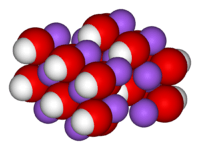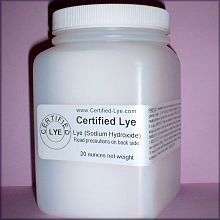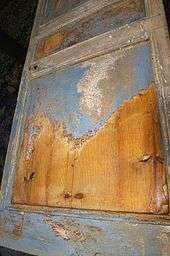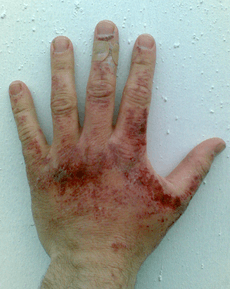Sodium hydroxide
 | |
 | |
| Names | |
|---|---|
| Preferred IUPAC name
Sodium hydroxide[1] | |
| Systematic IUPAC name
Sodium oxidanide[2] | |
| Other names | |
| Identifiers | |
| 1310-73-2 | |
| ChEBI | CHEBI:32145 |
| ChemSpider | 14114 |
| EC Number | 215-185-5 |
| 68430 | |
| Jmol interactive 3D | Image |
| KEGG | D01169 |
| MeSH | Sodium+Hydroxide |
| PubChem | 14798 |
| RTECS number | WB4900000 |
| UNII | 55X04QC32I |
| UN number | 1823 |
| |
| |
| Properties | |
| NaOH | |
| Molar mass | 39.9971 g mol−1 |
| Appearance | White, waxy, opaque crystals |
| Odor | odorless |
| Density | 2.13 g/cm3 |
| Melting point | 318 °C (604 °F; 591 K) |
| Boiling point | 1,388 °C (2,530 °F; 1,661 K) |
| 418 g/L (0 °C) 1110 g/L (20 °C) 3370 g/L (100 °C) | |
| Solubility | soluble in glycerol negligible in ammonia insoluble in ether |
| Solubility in methanol | 238 g/L |
| Solubility in ethanol | <<139 g/L |
| Vapor pressure | <2.4 kPa (at 20 °C) |
| Basicity (pKb) | 0.2[5] |
| Refractive index (nD) |
1.3576 |
| Thermochemistry | |
| 59.66 J/mol K | |
| Std molar entropy (S |
64 J·mol−1·K−1[6] |
| Std enthalpy of formation (ΔfH |
−427 kJ·mol−1[6] |
| Gibbs free energy (ΔfG˚) |
-380.7 kJ/mol |
| Hazards | |
| Safety data sheet | External MSDS |
| GHS pictograms |  |
| EU classification (DSD) |
|
| R-phrases | R35 |
| S-phrases | (S1/2), S26, S37/39, S45 |
| NFPA 704 | |
| Lethal dose or concentration (LD, LC): | |
| LD50 (Median dose) |
40 mg/kg (mouse, intraperitoneal)[7] |
| LDLo (Lowest published) |
500 mg/kg (rabbit, oral)[8] |
| US health exposure limits (NIOSH): | |
| PEL (Permissible) |
TWA 2 mg/m3[9] |
| REL (Recommended) |
C 2 mg/m3[9] |
| IDLH (Immediate danger |
10 mg/m3[9] |
| Related compounds | |
| Other anions |
Sodium hydrosulfide |
| Other cations |
Caesium hydroxide |
| Except where otherwise noted, data are given for materials in their standard state (at 25 °C [77 °F], 100 kPa). | |
| | |
| Infobox references | |
Sodium hydroxide (NaOH), also known as lye and caustic soda,[3][4] is an inorganic compound. It is a white solid and highly caustic metallic base and alkali salt of sodium which is available in pellets, flakes, granules, and as prepared solutions at a number of different concentrations.[10] Sodium hydroxide forms an approximately 50% (by weight) saturated solution with water.[11]
Sodium hydroxide is soluble in water, ethanol, and methanol. This alkali is deliquescent and readily absorbs moisture and carbon dioxide in air.
Sodium hydroxide is used in many industries, mostly as a strong chemical base in the manufacture of pulp and paper, textiles, drinking water, soaps and detergents and as a drain cleaner. Worldwide production in 2004 was approximately 60 million tonnes, while demand was 51 million tonnes.[12]
Properties
Physical properties
Pure sodium hydroxide is a whitish solid, sold in pellets, flakes, and granular form, as well as in solution. It is highly soluble in water, with a lower solubility in ethanol and methanol, but is insoluble in ether and other non-polar solvents.
Similar to the hydration of sulfuric acid, dissolution of solid sodium hydroxide in water is a highly exothermic reaction in which a large amount of heat is liberated, posing a threat to safety through the possibility of splashing. The resulting solution is usually colourless and odorless. As with other alkaline solutions, it feels slippery when it comes in contact with skin.
Chemical properties
Reaction with acids
Sodium hydroxide reacts with protic acids to produce water and the corresponding salts. For example, when sodium hydroxide reacts with hydrochloric acid, sodium chloride is formed:
In general, such neutralization reactions are represented by one simple net ionic equation:
This type of reaction with a strong acid releases heat, and hence is exothermic. Such acid-base reactions can also be used for titrations. However, sodium hydroxide is not used as a primary standard because it is hygroscopic and absorbs carbon dioxide from air.
Reaction with acidic oxides
Sodium hydroxide also reacts with acidic oxides, such as sulfur dioxide. Such reactions are often used to "scrub" harmful acidic gases (like SO2 and H2S) produced in the burning of coal and thus prevent their release into the atmosphere. For example,
Reaction with amphoteric metals and oxides
Glass reacts slowly with aqueous sodium hydroxide solutions at ambient temperatures to form soluble silicates. Because of this, glass joints and stopcocks exposed to sodium hydroxide have a tendency to "freeze". Flasks and glass-lined chemical reactors are damaged by long exposure to hot sodium hydroxide, which also frosts the glass. Sodium hydroxide does not attack iron since iron does not have amphoteric properties (i.e., it only dissolves in acid, not base). A few transition metals, however, may react vigorously with sodium hydroxide.
In 1986, an aluminium road tanker in the UK was mistakenly used to transport 25% sodium hydroxide solution,[13] causing pressurization of the contents and damage to the tanker. The pressurization was due to the hydrogen gas which is produced in the reaction between sodium hydroxide and aluminium:
- 2 Al + 2 NaOH + 6 H2O → 2 NaAl(OH)4 + 3 H2
Precipitant
Unlike sodium hydroxide, the hydroxides of most transition metals are insoluble, and therefore sodium hydroxide can be used to precipitate transition metal hydroxides. The following colours are observed: blue-copper, green-iron(II), yellow/brown-iron(III). Zinc and lead salts dissolve in excess sodium hydroxide to give a clear solution of Na2ZnO2 or Na2PbO2.
Aluminium hydroxide is used as a gelatinous flocculant to filter out particulate matter in water treatment. Aluminium hydroxide is prepared at the treatment plant from aluminium sulfate by reacting it with sodium hydroxide or carbonate.
- Al2(SO4)3 + 6 NaOH → 2 Al(OH)3 + 3 Na2SO4
- Al2(SO4)3 + 6 NaHCO3 → 2 Al(OH)3 + 3 Na2SO4 + 6 CO2
Saponification
Sodium hydroxide can be used for the base-driven hydrolysis of esters (as in saponification), amides and alkyl halides. However, the limited solubility of sodium hydroxide in organic solvents means that the more soluble potassium hydroxide (KOH) is often preferred. Touching sodium hydroxide solution with the bare hands, while not recommended, produces a slippery feeling. This happens because the oils of the hand are converted to soap.
Production
Sodium hydroxide is industrially produced as a 50% solution by variations of the electrolytic chloralkali process. Chlorine gas is also produced in this process. Solid sodium hydroxide is obtained from this solution by the evaporation of water. Solid sodium hydroxide is most commonly sold as flakes, prills, and cast blocks.[12]
In 2004, world production was estimated at 60 million dry metric tonnes of sodium hydroxide, and demand was estimated at 51 million tonnes.[12] In 1998, total world production was around 45 million tonnes. North America and Asia collectively contributed around 14 million tonnes, while Europe produced around 10 million tonnes. In the United States, the major producer of sodium hydroxide is the Dow Chemical Company, which has annual production around 3.7 million tonnes from sites at Freeport, Texas, and Plaquemine, Louisiana. Other major US producers include Oxychem, PPG, Olin, Pioneer Companies, Inc. (PIONA, which was purchased by Olin), and Formosa. All of these companies use the chloralkali process.[14]
Historically, sodium hydroxide was produced by treating sodium carbonate with calcium hydroxide in a metathesis reaction. (Sodium hydroxide is soluble while calcium carbonate is not.) This process was called causticizing.[15]
- Ca(OH)2(aq) + Na2CO3(s) → CaCO3 ↓ + 2 NaOH(aq)
This process was superseded by the Solvay process in the late 19th century, which was in turn supplanted by the chloralkali process which we use today.
Sodium hydroxide is also produced by combining pure sodium metal with water. The byproducts are hydrogen gas and heat, often resulting in a flame, making this a common demonstration of the reactivity of alkali metals in academic environments; however, it is not commercially viable, as the isolation of sodium metal is typically performed by reduction or electrolysis of sodium compounds including sodium hydroxide.
Uses

Sodium hydroxide is a popular strong base used in industry. Around 56% of sodium hydroxide produced is used by industry, 25% of which is used in the paper industry. Sodium hydroxide is also used in the manufacture of sodium salts and detergents, pH regulation, and organic synthesis. It is used in the Bayer process of aluminium production.[12] In bulk, it is most often handled as an aqueous solution,[16] since solutions are cheaper and easier to handle.
Sodium hydroxide is used in many scenarios where it is desirable to increase the alkalinity of a mixture, or to neutralize acids.
For example, in the petroleum industry, sodium hydroxide is used as an additive in drilling mud to increase alkalinity in bentonite mud systems, to increase the mud viscosity, and to neutralize any acid gas (such as hydrogen sulfide and carbon dioxide) which may be encountered in the geological formation as drilling progresses.
Poor quality crude oil can be treated with sodium hydroxide to remove sulfurous impurities in a process known as caustic washing. As above, sodium hydroxide reacts with weak acids such as hydrogen sulfide and mercaptans to yield non-volatile sodium salts, which can be removed. The waste which is formed is toxic and difficult to deal with, and the process is banned in many countries because of this. In 2006, Trafigura used the process and then dumped the waste in Africa.[17][18]
Chemical pulping
Sodium hydroxide is also widely used in pulping of wood for making paper or regenerated fibers. Along with sodium sulfide, sodium hydroxide is a key component of the white liquor solution used to separate lignin from cellulose fibers in the kraft process. It also plays a key role in several later stages of the process of bleaching the brown pulp resulting from the pulping process. These stages include oxygen delignification, oxidative extraction, and simple extraction, all of which require a strong alkaline environment with a pH > 10.5 at the end of the stages.
Tissue digestion
In a similar fashion, sodium hydroxide is used to digest tissues, as in a process that was used with farm animals at one time. This process involved placing a carcass into a sealed chamber, then adding a mixture of sodium hydroxide and water (which breaks the chemical bonds that keep the flesh intact). This eventually turns the body into a liquid with coffee-like appearance,[19][20] and the only solid that remains are bone hulls, which could be crushed between one's fingertips.[21] Sodium hydroxide is frequently used in the process of decomposing roadkill dumped in landfills by animal disposal contractors.[20] Due to its low cost and availability, it has been used to dispose of corpses by criminals. Italian serial killer Leonarda Cianciulli used this chemical to turn dead bodies into soap.[22] In Mexico, a man who worked for drug cartels admitted disposing of over 300 bodies with it.[23] In school laboratories for 13- to 16-year-olds, sodium hydroxide is one of the most dangerous chemicals due to its ability to hydrolyze protein. If a dilute solution is spilled on the skin, burns may result if the area is not washed thoroughly and for several minutes with running water. However splashes in the eye can be more serious and can lead to blindness.[24] This danger is often overlooked.
Dissolving amphoteric metals and compounds
Strong bases attack aluminium. Sodium hydroxide reacts with aluminium and water to release hydrogen gas. The aluminium takes the oxygen atom from sodium hydroxide, which in turn takes the oxygen atom from the water, and releases the two hydrogen atoms, The reaction thus produces hydrogen gas and sodium aluminate. In this reaction, sodium hydroxide acts as an agent to make the solution alkaline, which aluminium can dissolve in. This reaction can be useful in etching, removing anodizing, or converting a polished surface to a satin-like finish, but without further passivation such as anodizing or alodining the surface may become degraded, either under normal use or in severe atmospheric conditions.
In the Bayer process, sodium hydroxide is used in the refining of alumina containing ores (bauxite) to produce alumina (aluminium oxide) which is the raw material used to produce aluminium metal via the electrolytic Hall-Héroult process. Since the alumina is amphoteric, it dissolves in the sodium hydroxide, leaving impurities less soluble at high pH such as iron oxides behind in the form of a highly alkaline red mud.
Other amphoteric metals are zinc and lead which dissolve in concentrated sodium hydroxide solutions to give sodium zincate and sodium plumbate respectively.
Esterification and transesterification reagent
Sodium hydroxide is traditionally used in soap making (cold process soap, saponification).[25] It was made in the nineteenth century for a hard surface rather than liquid product because it was easier to store and transport.
For the manufacture of biodiesel, sodium hydroxide is used as a catalyst for the transesterification of methanol and triglycerides. This only works with anhydrous sodium hydroxide, because combined with water the fat would turn into soap, which would be tainted with methanol. NaOH is used more often than potassium hydroxide because it is cheaper and a smaller quantity is needed.
Sodium hydroxide is also being used experimentally in a new technology to create synthetic gasoline.[26]
Food preparation
Food uses of sodium hydroxide include washing or chemical peeling of fruits and vegetables, chocolate and cocoa processing, caramel coloring production, poultry scalding, soft drink processing, and thickening ice cream.[27] Olives are often soaked in sodium hydroxide for softening; Pretzels and German lye rolls are glazed with a sodium hydroxide solution before baking to make them crisp. Owing to the difficulty in obtaining food grade sodium hydroxide in small quantities for home use, sodium carbonate is often used in place of sodium hydroxide.[28]
Specific foods processed with sodium hydroxide include:
- The Scandinavian delicacy known as lutefisk (from lutfisk, "lye fish").
- Hominy is dried maize (corn) kernels reconstituted by soaking in lye-water. These expand considerably in size and may be further processed by frying to make corn nuts or by drying and grinding to make grits. Nixtamal is similar, but uses calcium hydroxide instead of sodium hydroxide.
- Sodium hydroxide is also the chemical that causes gelling of egg whites in the production of Century eggs.
- German pretzels are poached in a boiling sodium carbonate solution or cold sodium hydroxide solution before baking, which contributes to their unique crust.
- Lye-water is an essential ingredient in the crust of the traditional baked Chinese moon cakes.
- Most yellow coloured Chinese noodles are made with lye-water but are commonly mistaken for containing egg.
- Some methods of preparing olives involve subjecting them to a lye-based brine.[29]
- The Filipino dessert (kakanin) called kutsinta uses a bit of lye water to help give the rice flour batter a jelly like consistency. A similar process is also used in the kakanin known as pitsi-pitsi or pichi-pichi except that the mixture uses grated cassava instead of rice flour.
Cleaning agent
Sodium hydroxide is frequently used as an industrial cleaning agent where it is often called "caustic". It is added to water, heated, and then used to clean process equipment, storage tanks, etc. It can dissolve grease, oils, fats and protein-based deposits. It is also used for cleaning waste discharge pipes under sinks and drains in domestic properties. Surfactants can be added to the sodium hydroxide solution in order to stabilize dissolved substances and thus prevent redeposition. A sodium hydroxide soak solution is used as a powerful degreaser on stainless steel and glass bakeware. It is also a common ingredient in oven cleaners.
A common use of sodium hydroxide is in the production of parts washer detergents. Parts washer detergents based on sodium hydroxide are some of the most aggressive parts washer cleaning chemicals. The sodium hydroxide-based detergents include surfactants, rust inhibitors and defoamers. A parts washer heats water and the detergent in a closed cabinet and then sprays the heated sodium hydroxide and hot water at pressure against dirty parts for degreasing applications. Sodium hydroxide used in this manner replaced many solvent-based systems in the early 1990s when trichloroethane was outlawed by the Montreal Protocol. Water and sodium hydroxide detergent-based parts washers are considered to be an environmental improvement over the solvent-based cleaning methods.


Sodium hydroxide is used in the home as a type of drain opener to unblock clogged drains, usually in the form of a dry crystal or as a thick liquid gel. The alkali dissolves greases to produce water soluble products. It also hydrolyzes the proteins such as those found in hair which may block water pipes. These reactions are sped by the heat generated when sodium hydroxide and the other chemical components of the cleaner dissolve in water. Such alkaline drain cleaners and their acidic versions are highly corrosive and should be handled with great caution.
Sodium hydroxide is used in some relaxers to straighten hair. However, because of the high incidence and intensity of chemical burns, manufacturers of chemical relaxers use other alkaline chemicals in preparations available to average consumers. Sodium hydroxide relaxers are still available, but they are used mostly by professionals.
A solution of sodium hydroxide in water was traditionally used as the most common paint stripper on wooden objects. Its use has become less common, because it can damage the wood surface, raising the grain and staining the colour.
Historical uses
Sodium hydroxide has been used for detection of carbon monoxide poisoning, with blood samples of such patients turning to a vermilion color upon the addition of a few drops of sodium hydroxide.[30] Today, carbon monoxide poisoning can be detected by CO oximetry.
Experimental
- Sodium hydroxide test for flavonoids
Safety

Like other corrosive acids and alkalis, drops of sodium hydroxide solutions can readily decompose proteins and lipids in living tissues via amide hydrolysis and ester hydrolysis, which consequently cause chemical burns and may induce permanent blindness upon contact with eyes.[3][4] Solid alkali can also express its corrosive nature if there is water, such as water vapor. Thus, protective equipment, like rubber gloves, safety clothing and eye protection, should be always used when handling this chemical or its solutions. The standard first aid measures for alkali spills on the skin is, as for other corrosives, irrigation with large quantities of water. Washing is continued for at least ten to fifteen minutes.
Moreover, dissolution of sodium hydroxide is highly exothermic, and the resulting heat may cause heat burns or ignite flammables. It also produces heat when reacted with acids.
Sodium hydroxide is corrosive to several metals, like aluminium which reacts with the alkali to produce flammable hydrogen gas on contact:[31]
- 2 Al + 2 NaOH + 2 H2O → 3 H2 + 2 NaAlO2
- 2 Al + 6 NaOH + x H2O → 3 H2 + 2 Na3AlO3 + x H2O
- 2 Al + 2 NaOH + 6 H2O → 3 H2 + 2 NaAl(OH)4
Sodium hydroxide is also mildly corrosive to glass, which can cause damage to glazing or freezing of ground glass joints. Careful storage is needed.
Commercial brands
- Red Devil Lye
- Lewis Lye
See also
References
- 1 2 "Sodium Hydroxide – Compound Summary". Retrieved June 12, 2012.
- ↑ "1310-73-2|Sodium hydroxide solution|Sigma Aldrich|sodium oxidanide". chembase.cn.
- 1 2 3 "Material Safety Datasheet" (PDF). certified-lye.com.
- 1 2 3 "Material Safety Datasheet 2" (PDF). hillbrothers.com.
- ↑ Polyprotic Acids & Bases. UC Davis ChemWiki
- 1 2 Zumdahl, Steven S. (2009). Chemical Principles 6th Ed. Houghton Mifflin Company. p. A23. ISBN 0-618-94690-X.
- ↑ Michael Chambers. "ChemIDplus – 1310-73-2 – HEMHJVSKTPXQMS-UHFFFAOYSA-M – Sodium hydroxide [NF] – Similar structures search, synonyms, formulas, resource links, and other chemical information.". nih.gov.
- ↑ "Sodium hydroxide". Immediately Dangerous to Life and Health. National Institute for Occupational Safety and Health (NIOSH).
- 1 2 3 "NIOSH Pocket Guide to Chemical Hazards #0565". National Institute for Occupational Safety and Health (NIOSH).
- ↑ "Sodium hydroxide solution". Sigma-Aldrich.
- ↑ Pubchem. "SODIUM HYDROXIDE | HNaO – PubChem". nih.gov.
- 1 2 3 4 Cetin Kurt, Jürgen Bittner (2005), "Sodium Hydroxide", Ullmann's Encyclopedia of Industrial Chemistry, Weinheim: Wiley-VCH, doi:10.1002/14356007.a24_345.pub2
- ↑ Stamell, Jim (2001), EXCEL HSC Chemistry, Pascal Press, p. 199, ISBN 978-1-74125-299-6
- ↑ Kirk-Othmer Encyclopedia of Chemical Technology, 5th edition, John Wiley & Sons.
- ↑ Deming, Horace G. (1925). General Chemistry: An Elementary Survey Emphasizing Industrial Applications of Fundamental Principles (2nd ed.). New York: John Wiley & Sons, Inc. p. 452.
- ↑ "Document 2 - CausticSodamanual2008.pdf" (PDF). 2013. Retrieved July 17, 2014.
- ↑ Sample, Ian (16 September 2009). "Trafigura case: toxic slop left behind by caustic washing". The Guardian. Retrieved 2009-09-17.
- ↑ "Trafigura knew of waste dangers". BBC Newsnight. 16 September 2009. Retrieved 2009-09-17.
- ↑ Ayres, Chris (27 February 2010) Clean green finish that sends a loved one down the drain Times Online. Retrieved 2013-02-20.
- 1 2 Thacker, H. Leon; Kastner, Justin (August 2004). Carcass Disposal: A Comprehensive Review. Chapter 6. National Agricultural Biosecurity Center, Kansas State University, 2004. Retrieved 2010-03-08
- ↑ Roach, Mary (2004). Stiff: The Curious Lives of Human Cadavers, New York: W.W. Norton & Company. ISBN 0-393-32482-6.
- ↑ "Sodium: Getting rid of dirt – and murder victims". BBC News. 3 May 2014.
- ↑ William Booth (January 27, 2009). "'Stewmaker' Stirs Horror in Mexico". Washington Post.
- ↑ http://www.atsdr.cdc.gov/MMG/MMG.asp?id=246&tid=45
- ↑ Morfit, Campbell (1856). A treatise on chemistry applied to the manufacture of soap and candles. Parry and McMillan.
- ↑ Andrew Hough (18 October 2012). "British engineers produce amazing 'petrol from air' technology". The Telegraph. Retrieved 21 October 2012.
- ↑ "Sodium Hydroxide". rsc.org. 2014. Retrieved November 9, 2014.
- ↑ "Hominy without Lye". National Center for Home Food Preservation.
- ↑ "Olives: Safe Methods for Home Pickling (application/pdf Object)" (PDF). ucanr.org. 2010. Retrieved January 22, 2012.
- ↑ Page 168 in: The Detection of poisons and strong drugs. Author: Wilhelm Autenrieth. Publisher: P. Blakiston's son & Company, 1909.
- ↑ "aluminium_water_hydrogen.pdf (application/pdf Object)" (PDF). www1.eere.energy.gov. 2008. Retrieved January 15, 2013.
Bibliography
- Euro Chlor-How is chlorine made? Chlorine Online
- Greenwood, Norman N.; Earnshaw, Alan (1997). Chemistry of the Elements (2nd ed.). Butterworth-Heinemann. ISBN 0-08-037941-9.
- Heaton, A. (1996) An Introduction to Industrial Chemistry, 3rd edition, New York:Blackie. ISBN 0-7514-0272-9.
External links
| Wikimedia Commons has media related to Sodium hydroxide. |
| Look up sodium hydroxide in Wiktionary, the free dictionary. |
- International Chemical Safety Card 0360
- NIOSH Pocket Guide to Chemical Hazards
- CDC – Sodium Hydroxide – NIOSH Workplace Safety and Health Topic
- European Union Risk Assessment Report
- Production by brine electrolysis
- Sodium Hydroxide Safety Data Sheet (SDS)
- Sodium hydroxide Safety Summary (BASF)
- Titration of acids with sodium hydroxide; freeware for data analysis, simulation of curves and pH calculation
- Caustic soda production in continuous causticising plant by lime soda process
| ||||||||||
| ||||||||||||||
|

